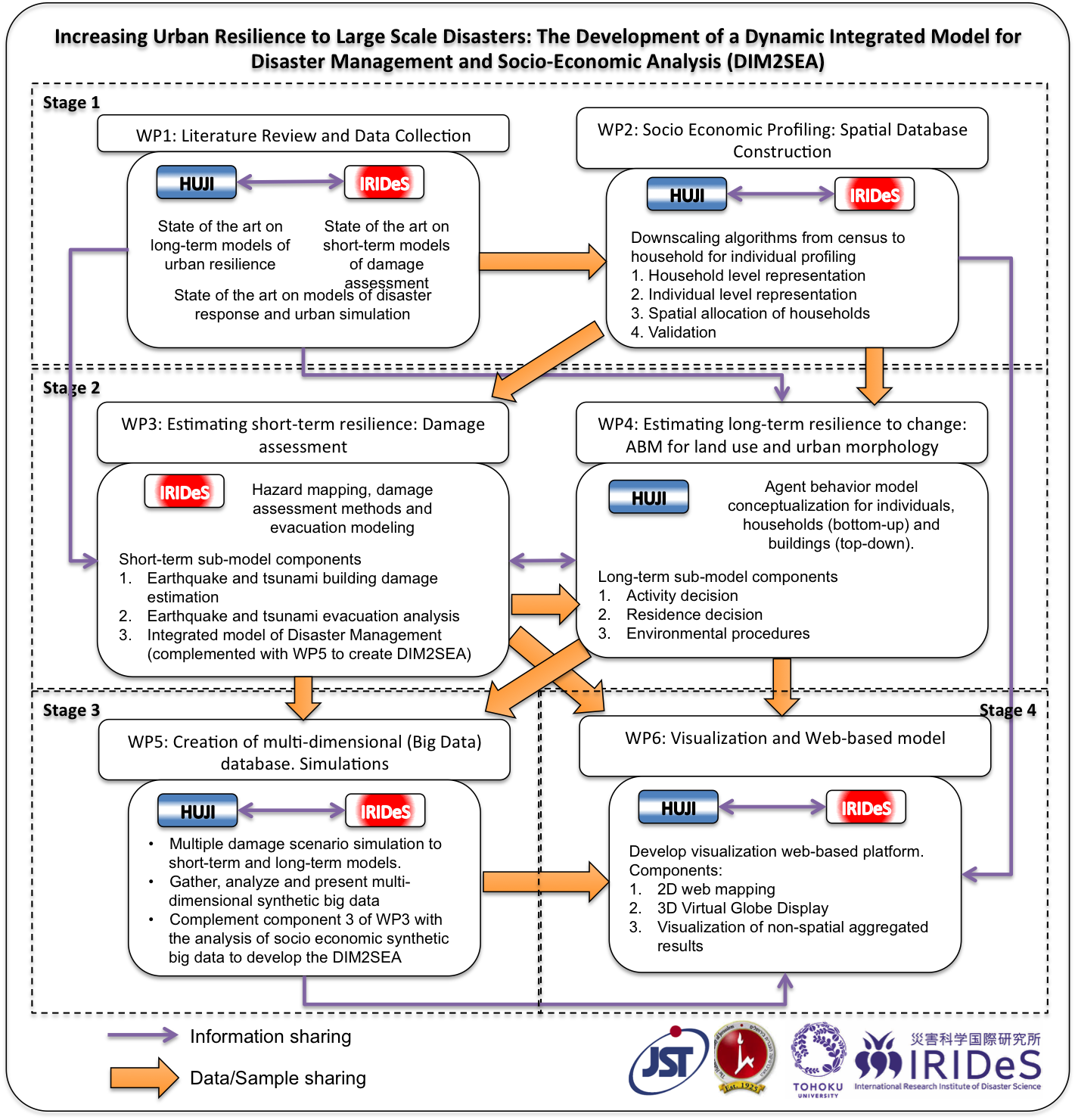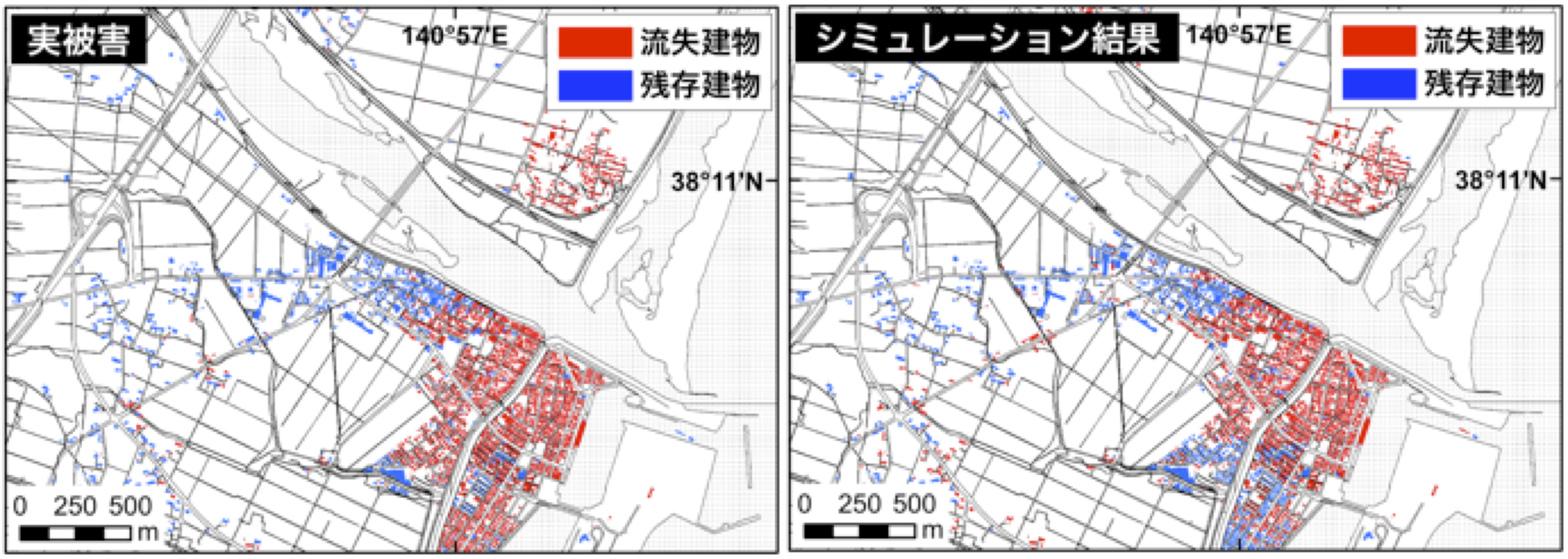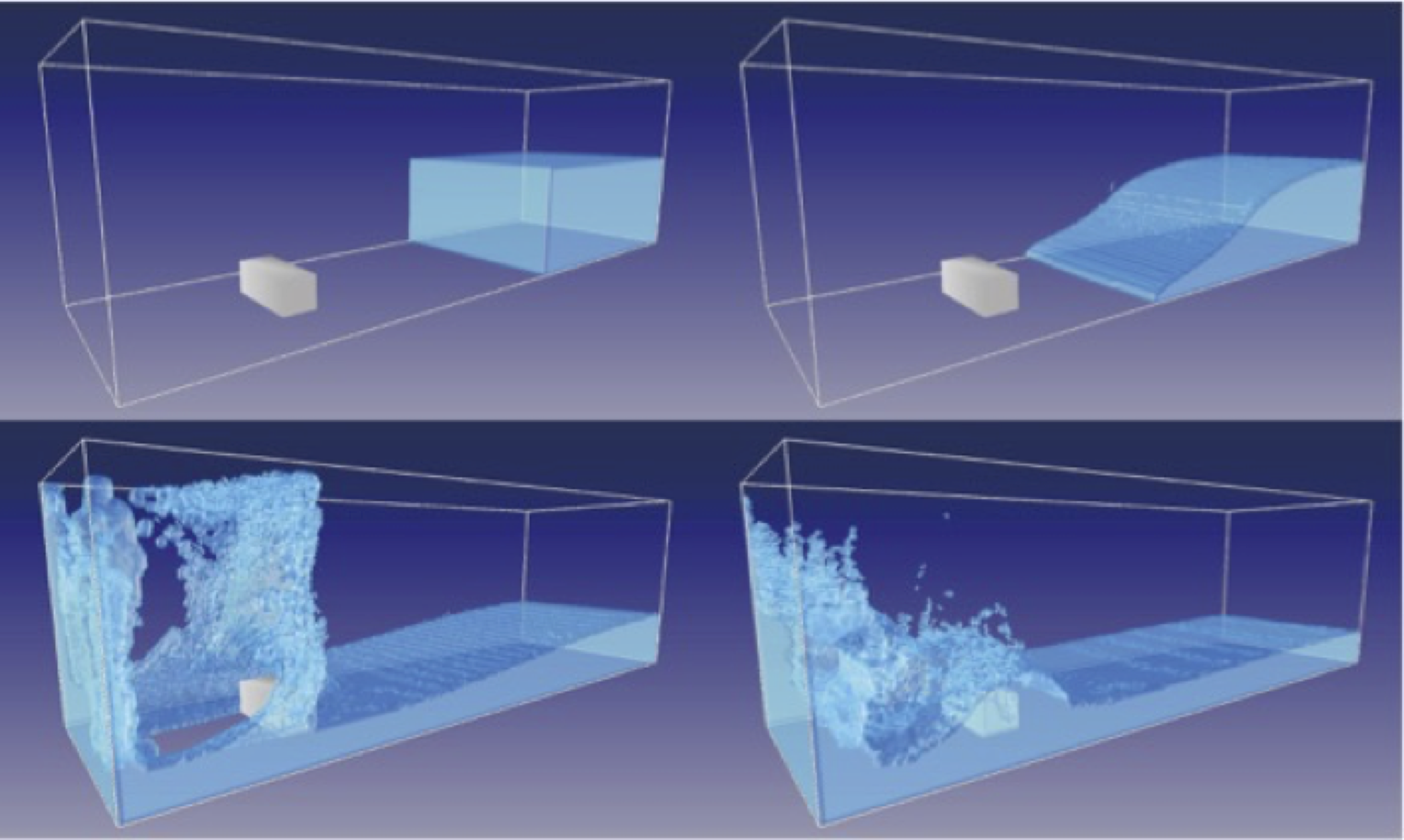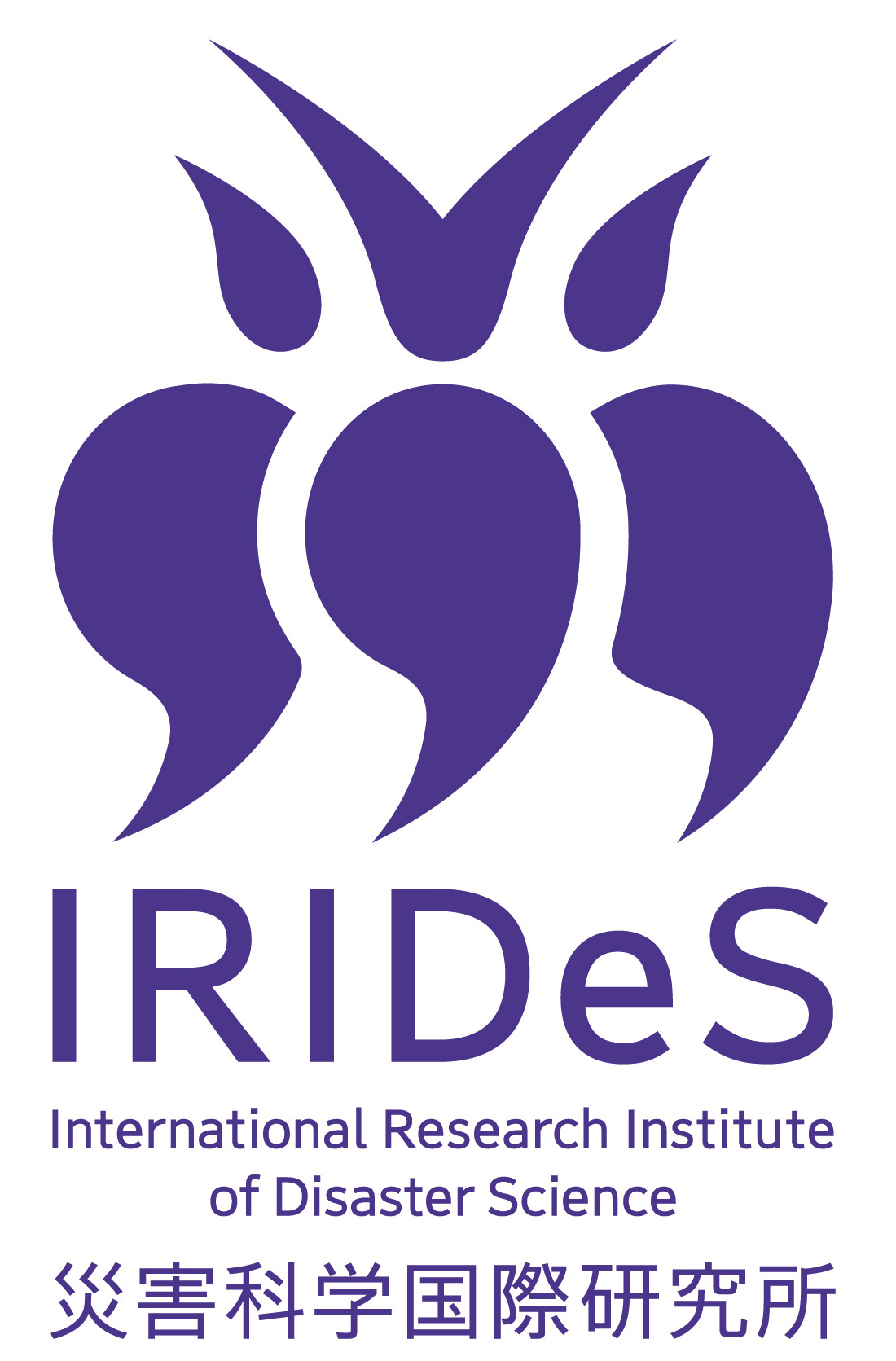RESEARCH (SIMULATION TEAM)
Research on real-time tsunami inundation and damage estimation
By using real-time earthquake information and supercomputing, we are working in collaboration with industry and universities on the development of technology for the estimation of tsunami damage in order to deliver this information within 20 minutes after the earthquake. This challenge is referred as the "Triple 10 (ten) Challenge Project", 10 minutes for the tsunami generation estimation, 10 minutes for tsunami inundation calculation at 10 m mesh. On of the world's first super computer was used to put on practice and develop the real-time tsunami inundation and damage prediction system. This was achieved through the collaboration with Professor Ryota Hino and Associate Professor Takeshisaku Ota from the Earthquake and Eruption Prediction Research Observation Center of the Graduate School of Science and Professor Hiroaki Kobayashi from the Cyber Science Center in Tohoku University. In addition, NEC, Kokusai Kogyo Co., Ltd. participated as industry collaborators inthe project. This project achievements are recognized by the Japan Resilience Award 2016 Excellence Award.

The creation of innovative earthquake and tsunami disaster mitigation big data analysis infrastructure through collaboration and data assimilation of large-scale, high-resolution numerical simulation
Been adopted in the area of the JST CREST (creation and advancement of next-generation applications technology for big data utilization promotion of each field toward scientific discovery and social problem-solving), we are working on this project from 2015. The world's most advanced disaster simulation, disaster management science, mathematical science, researchers and cooperation of information science, with the goal of saving lives in the earthquake and tsunami disaster to be the future of national crisis, large-scale, high-resolution real-time through collaboration and real-time observation data assimilation of numerical simulations, it will create the world's first big data analysis base and Mitigation system. This together with presenting the measures to avoid the worst-case scenario and that in the disaster in real time, plays the implementation of disaster prevention systems, such as national and local governments.

Increasing Urban Resilience to Large Scale Disasters: The Development of a Dynamic Integrated Model for Disaster Management and Socio-Economic Analysis
The purpose of this study is to build a simulation platform for effectively deploying large-scale disaster assessment, response plans and mitigation measures. The Japanese side, by using simulation and remote sensing techniques is in charge of performing a short-term damage assessment, while the Israel side, together with the simulation group from the Japanese side, develops the damage observation and agent simulation of detailed land use models integrated on GIS. Through the Japan and Israel efforts, an integrated disaster management tool is built on a spatial and temporal level of detail not present so far and that can be shared in both countries. In recent years it is rapidly expected to take advantage of social big data and effectively protect lives in the field of disaster through the use of the data.

South American tsunami prediction sophistication by fusion of real-time tsunami simulation and Remote Sensing
In recent years, there has been an increase of tsunami disasters by huge earthquake in Central and South America which had significant impact on the Pacific Ocean countries, including Japan. To improve resilience in Latin American countries tsunami prone areas threaten by extreme events, we establish a wide area damage grasp technology that combines real-time computing technology and remote sensing technology in order to grasp the full extent of the damage in case of disaster. Moreover, earthquake and tsunami events that occur in Central and South America were divided into near-field tsunamis and far-field tsunami damage prediction to carry out impact assessment. To implement each approach in real time, we have developed a GIS-based system for building damage estimation using real-time tsunami simulation and tsunami fragility functions.

Construction of tsunami simulation that reflects the building damage
In order to predict the tsunami damage that may occur in the future more accurately, we need to know understand the tsunami behavior when flooding. However, in urban areas, a dense layout of structures, such as houses, represent an obstacle for the tsunami flow. It is very difficult to obtain a precise tsunami force acting on structures. Nevertheless, we have built a simulation technique to reproduce the manner in which along with the flood of tsunami in urban areas, buildings will be washed away (a time evolved synthetic equivalent roughness model). In this simulation, when the tsunami is entering the city, we aim to find out "which building is being washed away", "the time when it was damaged", "the number of buildings that where washed away". This approach, applied in the Sendai Plain (Natori River estuary), reproduced the building damage of the 2011 Tohoku tsunami. As a result, we estimate the actual disaster situation and post damage that were compared with aerial images taken at the time of the disaster. The model of tsunami inundation and building destruction was able to reproduce the event and damage.

The development of next-generation tsunami simulation technique due to the Lattice Boltzmann method
Numerical simulation technique of tsunami made a rapid progress with the dramatic improvement in the performance of the computer, now can be analyzed in less than 10% error with respect to the tsunami height. Searching for practical simulation approaches besides traditional techniques, we aim to reproduce the tsunami runup into the city. The prediction of such physical phenomenon traditionally requires advanced simulation by 3D CFD model. However, the simulation of large-scale tsunami caused by the three-dimensional fluid analysis, demand a large load of calculations, thus we need to take advantage of supercomputing. Traditional methods have been realized under limited computing environments so far. In this research, by developing tsunami simulation using the lattice Boltzmann method, we explore the potential to overwhelmingly surpass current calculation speed limits, thus, we are developing a tsunami simulation technique of the next generation.

Construction of rapid estimation method of tsunami worst-case scenario using the earthquake early warning information
Using the emergency earthquake bulletin obtained immediately after the earthquake, we are studying a technique to assess the highest possible damage immediately by estimating the tsunami worst-case scenario. By underestimation of tsunami warning in the Great East Japan Earthquake, evacuation was delayed and became a problem. Thus, to estimate the "Possible worst-case of tsunami" as a preliminary assessment, it is possible to assume the worst case in light of the uncertainty of initial conditions. During a disaster, the earliest available information is the earthquake early warning, using such information, we set up a number of tsunami scenario and build an efficient method for estimating the tsunami worst-case scenario in real-time. By this analysis method, in approximate 3 minutes, we were able to estimate the maximum wave height which may occur in the worst case scenario with an average of 97% of accuracy.

RESEARCH (REMOTE SENSING TEAM)
Study on the understanding of earthquake building damage using satellite multi-polarization SAR image
This study highlights the earthquake induced building damage assessment by investigating a single post-seismic dual polarimetric ALOS2/PALSAR2 image. The spaceborne ALOS2/PALSAR2 dual polarimetric dataset has a good perspective to distinguish the slightly damaged buildings with the collapsed buildings and the tilt buildings. In this study, the initial polarimetric SAR analysis of built-up areas with different damage level in single post-event SAR image is conducted using machine learning algorithms. The 2015 Nepal earthquake, and the damage in the Kathmandu district was used as a testing area. The method was able to satisfactorily detect building damage in the area.

Development of flooded region extracting technique in urban area using L- band SAR image
This research is committed to grasp the flood area within the urban environment using SAR images. The 2015 September Kanto and Tohoku heavy rain was used as a case study.

OTHER RESEARCH TOPICS
Study on the multi-agent simulation in disaster response
Human behavior simulation in large-scale disasters, such as the Great East Japan Earthquake, is performed using the agent-based approach. By reproducing the disaster situation on the computer, this research intends to discover and clarify the issues related to rescue operations.
Improvement of feature extraction using a synthetic aperture radar
This research uses remote sensing techniques to grasp the damage situation in the event of a disaster. We classify the damage observed in the SAR image by considering the changes on pre- versus post-images using various methods.
Run-up calculation of tsunami using the Lattice Boltzmann method in shallow water long wave theory
Finite difference method has been used in the tsunami run-up calculation for years, currently the finite volume method using a Lattice Boltzmann method (LBM), which is a completely new approach, is being developed. Land run-up calculation of the tsunami in shallow water long wave theory using LBM is the core of this research. The fluid is regarded as a collection of virtual particles moving on a regular grid, a collision and translation of the time evolution of the virtual particles represented by the lattice Boltzmann equation is used to calculate the motion of the fluid. LBM is a completely explicit time development scheme, facing a large-scale parallel computing needs, thus, the speed of calculation can be expected using supercomputing.
